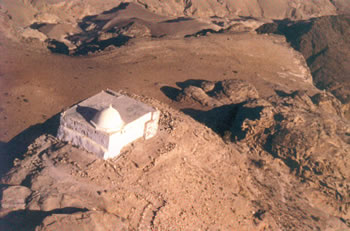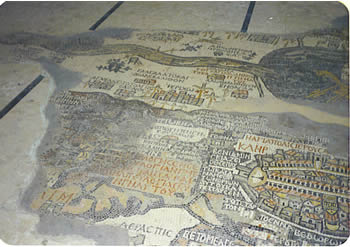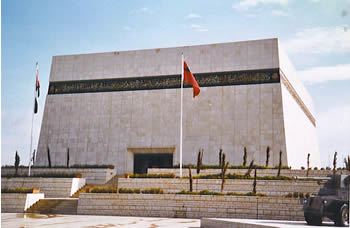|
"Jewish" Jordan
By Jay Levinson
The initial enthusiasm that brought waves of Israeli tourists swarming into Jordan after the peace treaty was signed is over. The "kosher" restaurant in Amman closed years ago and is now forgotten. Even the grocer who was toying with the idea of storing kosher frozen dinners dropped the possibility. Even though the initial rush of Jewish tourists is over, Jordan remains an exciting destination for a Jewish tourist.
Petra / Jebel Haroun

(Courtesy of Jordanian Ministry of Tourism & Antiquities)
Very definitely, Jordan does have a Jewish history, although there are not many specifically Jewish sites. The major exception is Hor HaHar, or Jebel Haroun in Arabic – the accepted grave of Aaron, who like Moses died before he could reach the Promised Land. But, the site is not appropriate for all tourists. The grave is atop a mountain in the Petra enclave. Particularly on the Yahrzeit, Rosh Chodesh Av, religious Jews do make the four to six hour trek to the grave, often assisted by the hire of donkeys. At the top there is a thirteenth century Moslem monument marking the spot. Any Jewish flavor to the visit is only that spirit which is self-generated by the visitor.
Advance arrangements and hire of a donkey with guide are highly recommended.
On the Road South
As Roman troops advanced southward from victory at Masada to battle against the Nabateans in Petra, en route they attacked and slaughtered Jews who had fled Jerusalem. Near the small town of Zora there are 1st century CE Jewish graves, later incorporated into a Byzantine non-Jewish cemetery.
Madaba

The Children of Israel wandered through Jordan before entering Eretz Yisroel, and Moses gazed out at the land before he died. We are told in the Torah that his grave is unknown. Thus, there is absolutely no reason to give credence to the tourist site hailing Moses' death on Mount Nebo, a location fixed in a "vision" in the fourth century by Helena, a noted non-Jew.
Seven miles from that mountain view there sits the town of Madaba, known for the famous sixth century mosaic map that so clearly depicts Jerusalem in the context of an area that stretches from Southern Syria to the Egyptian city of Thebes. Again, however, Jewish interest is limited by the location of the mosaic – on the floor of a local church. (A replica of a segment of the map is on display in Jerusalem's Cardo.)
Cities of the Plain
There is an impressive list of possible locations in Jordan for Biblical sites, for example in the time of Sodom and Amora when the Cities of the Plain might well have been on both sides of modern borders, but very little is certain, and in any case there is little other than Hor HaHar of true religious significance.
Amman / Citadel
The Museum in the Citadel, located atop a mountain with a strategic view of Amman, houses part of the Dead Sea Scrolls. There are also artifacts from the Biblical era of the Patriarchs. The display is poor, but that should be changed when the new National Museum of Jordan finally opens after numerous delays.
Amman / Martyrs' Memorial

In 1977 Jordanian King Hussein ordered the establishment of a national memorial to soldiers who fell in the line of duty since the Arab Revolt of 1916-1919. Not long thereafter the Martyrs' Memorial, designed by Victor Adel Bisharat (1920-1996), opened in Amman, Jordan's capital, with the goal of enshrining the memory of those who gave their lives for their country.
The memorial begins with the Arab Revolt against the Ottoman Empire. The revolt, which included 100,000 Arabs united under the leadership of Sharif Hussein bin Ali, began on 10 June 1916. It was not a Jordanian war. It was an Arab uprising against non-Arab occupation. A year later Aqaba was wrestled from Ottoman control, and on 25 January 1918 the Ottoman Empire was totally routed. The memorial is careful to skirt sensitive problems. It is not unreasonable, though, to consider the 1920-1921 anti-Jewish riots in Palestine as an outgrowth of the Pan-Arabism spirit that swept the area at the time.
A key target of the revolt was the relatively new Hejaz Railroad, which was a backbone of Ottoman communications. Blatantly missing in the memorial are the exploits of "Lawrence of Arabia" (Thomas Edward Lawrence, 1888-1935) and his attack on the railroad, despite his famous role in fighting the Ottomans. After all, Lawrence was British. It is, perhaps, hard to place him as a leader in an Arab revolt.
Amazingly enough, the Amman-Damascus segment of the Hejaz Railroad still carries passengers today. Dingy but authentic trains depart Amman on Monday and Thursday at 0800 and return later the same day. A trip to Mafraq on the Jordanian side of the border, without entry into Syria, can be a delightful and very different experience. The rolling stock is not unlike the Ottoman cars that were used in Palestine before "modernization" under the British.
Abdullah bin Hussein next lead the Trans-Jordan, first as leader of the Emirate created in 1923, then as King. In 1930 he appointed John Bagot Glubb (1897-1986) to establish th Desert Patrol. From 1939 until 1956 Glubb served as commander of the Arab Legion, the name given to the Jordanian army at the time. It was under Glubb's leadership that the Legion fought against Israeli forces during Israel's War of Independence.
The museum has models recreating 1948 battles in Bab El-Wad/Latrun. The Arab goal was to cut the communications and supply lines between besieged Jerusalem and Zionist forces in the Tel Aviv and Shefela areas. Another of the items in the memorial is a large painting (to the left of the entrance) depicting a fierce battle at Jerusalem's Flower (Herod's) Gate in 1948.
The years that followed saw repeated conflict with Israel. There were Israeli successes. There were Jordanian successes. Amongst the items on display in the museum are captured Israeli military rations and an IDF rifle.
The Six Day War is glossed over in the museum, but the 1968 Battle of Karameh is highlighted. After all, the museum is not an academic chronology of military events. It is nominally a memorial to the fallen, but in a wider sense it is an effort to remember the contribution of the fallen to the success of shaping modern Jordan. The Six Day War was a Jordanian military failure. Karameh, a year later, was the regaining of Jordanian pride.
In the exhibition mention is also made of Jordanian troops dispatched to the Golan in 1973 and a 1975 border confrontation.
A visit to the Martyrs' Memorial is definitely recommended. It gives better understanding to the history of a country that has shown how differences can be resolved through negotiation.
Qasr Al-Amir
The Roman era historian, Josephus, relates (Antiquities XII-XIV) an interesting story. For twenty-two years during the reigns of Ptolmey III and Ptolmey IV, Joseph of Tobiades was a tax collector based in Jerusalem. In 209 BCE the aging Joseph sent his son with lavish gifts to Hyrcanus to celebrate the birth of Ptolmey V. The son became a favorite of Hyrcanus, whose brothers became jealous and attempted to kill him. He fled Jerusalem and took refuge in the Trans-Jordanian desert, where he built a well-guarded fortress. Details about Qasr-Al-Amir can be found in the April 2006 issue of Jewish Magazine.
Conclusion
A visit to Jordan can be a rewarding experience for the tourist, but careful and prudent behavior is a prudent guideline. There is a definite trend toward the Islamization of Jordan. Traditional dress is more common than ten years ago, and there are more mosques than ever before. Arabic copies of the Protocols of the Elders of Zion and similar titles are available on sale. Anti-Semitic acts, however, are strictly outlawed, and the government has clamped down on openly inciting conduct.
After dozens of trips this writer can say that he has never encountered any unpleasant problems.
~~~~~~~
from the May 2009 Edition of the Jewish Magazine
|
